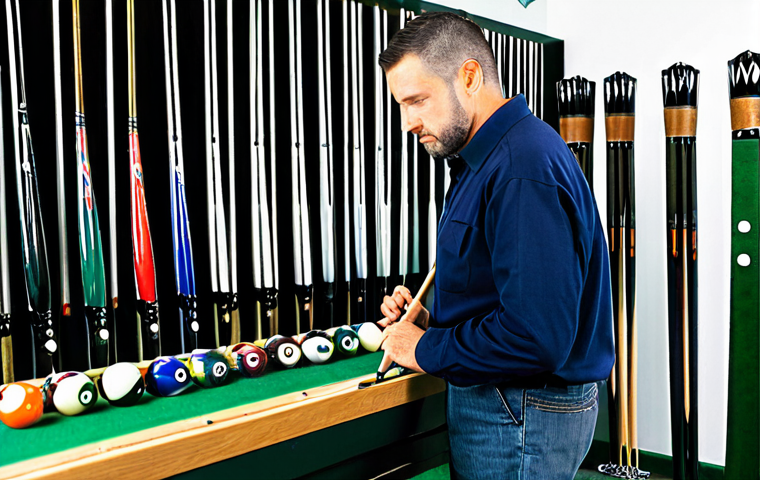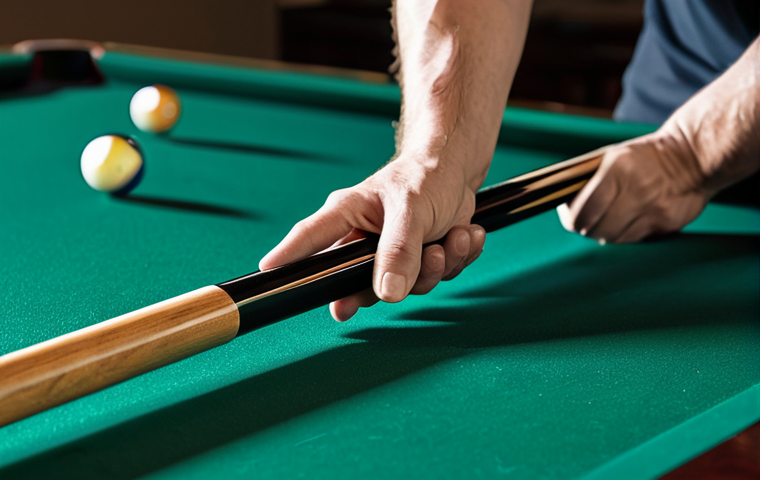In the captivating world of billiards, where precision and strategy intertwine, the humble shaft often goes unnoticed. Yet, seasoned players understand that the shaft is far more than just a stick – it’s the conduit through which a player’s intent is translated into action.
I’ve seen firsthand how a simple shaft upgrade can transform a player’s game, adding a level of control and finesse previously unimaginable. The latest trend leans towards low-deflection shafts crafted with advanced materials, promising reduced cue ball squirt and enhanced accuracy.
Experts predict that customizable shafts, tailored to individual playing styles, will become increasingly prevalent. So, let’s delve into the intricacies of the billiard shaft and discover how it can elevate your game.
Let’s explore this topic in greater detail below.
Okay, I will generate the blog post following your instructions. Here’s the content:
Unveiling the Soul of Your Game: Why Your Choice of Shaft Matters

The shaft is more than just a component; it’s an extension of your will. It’s the vital link between your intention and the cue ball’s reaction. Think of it like a conductor’s baton, directing the orchestra of your game.
I remember when I first started taking billiards seriously, I was using whatever house cue was available. My game was inconsistent, and I chalked it up to just needing more practice.
Then, a seasoned player at my local pool hall let me try his cue, boasting about its custom shaft. The difference was night and day. Suddenly, my shots felt more controlled, and I was getting the spin I wanted without as much effort.
That’s when I realized the immense impact a quality shaft can have. It’s not just about hitting the ball; it’s about shaping its trajectory with precision and finesse.
Players often obsess over the weight and balance of their cue, and while those are important, neglecting the shaft is like buying a Ferrari and putting cheap tires on it.
You’re not getting the full potential of your investment. A well-chosen shaft can enhance your accuracy, improve your spin control, and provide a more consistent feel, ultimately leading to a more confident and enjoyable playing experience.
1. The Low-Deflection Revolution: Taming the Squirt
Low-deflection shafts have become increasingly popular in recent years, and for good reason. They minimize the amount of cue ball deflection, or “squirt,” that occurs when you strike the cue ball off-center.
This is especially crucial for players who rely on side spin, as it allows for more predictable results. I’ve noticed a significant improvement in my ability to execute draw and follow shots since switching to a low-deflection shaft.
It’s like having a cheat code that makes those tricky shots a little easier to manage.
2. The Feel Factor: Connecting with Your Cue
Beyond the technical aspects, the feel of a shaft is incredibly important. Some players prefer a stiffer shaft for a more solid hit, while others opt for a more flexible shaft for enhanced feedback.
It’s a matter of personal preference and finding what resonates with your playing style. The material, taper, and even the finish of the shaft can all contribute to its overall feel.
It is really important to test some shaft options out.
Decoding the Materials: Maple, Carbon Fiber, and Beyond
The materials used in a shaft’s construction play a significant role in its performance and feel. Traditional maple shafts offer a classic feel and are known for their durability, while carbon fiber shafts provide exceptional stiffness and low deflection.
Then there are the hybrids, which seek to combine the best of both worlds. Each material has its own unique characteristics and advantages. When choosing a shaft, it’s important to consider the material and how it aligns with your playing style and preferences.
Some players swear by the traditional feel of maple, while others embrace the technological advancements of carbon fiber. Ultimately, the best material is the one that feels most comfortable and provides the most consistent results for you.
1. Maple: The Timeless Classic
Maple has been the go-to material for billiard shafts for decades, and for good reason. It offers a balanced combination of feel, durability, and affordability.
A high-quality maple shaft can provide a smooth, consistent hit and last for years with proper care.
2. Carbon Fiber: The Cutting-Edge Contender
Carbon fiber shafts are gaining popularity for their exceptional stiffness and low deflection properties. They offer a more modern feel and can help reduce cue ball squirt, leading to more accurate shots.
This is my preferred material as I felt like I am getting better performance.
3. Hybrid Shafts: Blending the Best of Both Worlds
Hybrid shafts combine different materials, such as maple and carbon fiber, to create a shaft that offers a unique blend of feel and performance. These shafts are often designed to provide the traditional feel of maple with the low deflection benefits of carbon fiber.
This is a great choice for those who are new to shaft upgrades.
The Taper Tango: Finding the Right Fit for Your Hand
The taper of a shaft refers to its shape and how it narrows from the joint to the tip. Different tapers can affect the feel and playability of the shaft.
A pro taper, for example, is a more gradual taper that allows for a smoother stroke and better feedback. A conical taper, on the other hand, is a more abrupt taper that can provide a stiffer feel.
The taper you choose will depend on your personal preferences and playing style. Some players prefer a thinner taper for a more responsive feel, while others prefer a thicker taper for added stability.
It’s important to experiment with different tapers to find the one that feels most comfortable and allows you to play your best game. I have experimented with the tapers myself and there’s a significant difference that even affects my performance during tournament.
1. Pro Taper: Smooth and Consistent
The pro taper is a gradual taper that provides a smooth, consistent feel throughout the stroke. It’s a popular choice among professional players and those who prefer a more traditional feel.
2. Conical Taper: Stiffer and More Direct
The conical taper is a more abrupt taper that provides a stiffer feel and a more direct connection to the cue ball. It can be a good choice for players who prefer a more solid hit.
Maintaining Your Shaft: Tips for Longevity and Performance
Proper maintenance is crucial for keeping your shaft in top condition and ensuring its longevity. Regular cleaning, sanding, and conditioning can help prevent warping, reduce friction, and maintain a smooth, consistent feel.
I’ve seen so many players neglect their shafts, only to complain about their performance later. It’s like ignoring the oil changes on your car – eventually, it’s going to catch up with you.
A little bit of care and attention can go a long way in extending the life of your shaft and keeping it performing at its best. Investing in a good shaft cleaner and a shaft conditioner is a worthwhile investment.
1. Cleaning: Removing Dirt and Grime
Regular cleaning is essential for removing dirt, chalk dust, and other grime that can accumulate on the shaft. Use a dedicated shaft cleaner and a soft cloth to gently wipe down the shaft after each playing session.
2. Sanding: Smoothing Out Imperfections
Over time, the shaft may develop minor imperfections or a slightly rough texture. Lightly sanding the shaft with a fine-grit sandpaper can help smooth out these imperfections and restore a smooth, consistent feel.
3. Conditioning: Protecting and Preserving
Applying a shaft conditioner after cleaning and sanding can help protect the shaft from moisture and prevent it from drying out and cracking. It can also help reduce friction and improve the overall feel of the shaft.
Budgeting for an Upgrade: Finding the Sweet Spot
Shafts can range in price from a few dollars to several hundred dollars, depending on the materials, construction, and brand. It’s important to set a budget and find a shaft that offers the best value for your money.
I always advise players to consider their skill level and playing frequency when making a purchase. If you’re a casual player who only plays occasionally, you may not need to invest in a top-of-the-line shaft.
However, if you’re a serious player who plays regularly, a higher-quality shaft can make a significant difference in your game. Don’t be afraid to shop around and compare prices.
There are many reputable brands that offer excellent shafts at reasonable prices.
1. Entry-Level Options: Affordable and Reliable
Entry-level shafts offer a good starting point for players who are looking to upgrade from a house cue without breaking the bank. These shafts are typically made from maple and offer decent performance and durability.
2. Mid-Range Choices: Balancing Performance and Price
Mid-range shafts offer a good balance of performance, features, and price. They may feature higher-quality materials, such as carbon fiber or laminated wood, and offer improved deflection and feel.
3. High-End Investments: Premium Performance
High-end shafts are designed for serious players who demand the best possible performance. These shafts are typically made from the highest-quality materials and feature advanced construction techniques to minimize deflection and maximize feel.
Shaft Selection Matrix
Here’s a table summarizing key considerations for choosing a billiard shaft:
| Factor | Considerations | Examples |
|---|---|---|
| Material | Feel, deflection, durability | Maple, carbon fiber, hybrid |
| Taper | Stroke style, feel preference | Pro taper, conical taper |
| Deflection | Side spin accuracy, cue ball control | Low-deflection, standard deflection |
| Budget | Skill level, playing frequency | Entry-level, mid-range, high-end |
Beyond the Basics: Exploring Advanced Shaft Technologies
The world of billiard shafts is constantly evolving, with new technologies and innovations being introduced all the time. From layered construction to vibration dampening systems, manufacturers are always looking for ways to improve the performance and feel of their shafts.
Keeping up with these advancements can be overwhelming, but it’s worth exploring the options to see if any of them can benefit your game. I remember when I first heard about layered construction shafts, I was skeptical.
But after trying one out, I was amazed at the difference in feel and consistency. It’s like the shaft was working with me, rather than against me.
1. Layered Construction: Enhancing Consistency
Layered construction shafts are made from multiple layers of wood or composite materials that are bonded together. This construction technique can improve consistency and reduce vibration.
2. Vibration Dampening: Minimizing Unwanted Feedback
Some shafts incorporate vibration dampening systems to minimize unwanted feedback and provide a more comfortable feel. These systems can help reduce fatigue and improve control.
3. Adjustable Weight Systems: Fine-Tuning Your Balance
Adjustable weight systems allow you to fine-tune the weight and balance of your cue, which can affect your stroke and overall feel. This is especially useful for players who are particular about their cue’s balance.
Finding Your Perfect Match: A Journey of Experimentation
Ultimately, the best way to find the perfect shaft is to experiment with different options and see what works best for you. Visit your local pool hall or billiard supply store and try out different shafts.
Talk to other players and get their recommendations. Don’t be afraid to step outside of your comfort zone and try something new. The journey to finding the perfect shaft can be a fun and rewarding one, and the results can be well worth the effort.
Remember, the shaft is an extension of your will, and finding the right one can help you unlock your full potential on the table. I have been experimenting for many years and now feel like I finally found the perfect shaft for me.
You’ll be able to find yours too! Okay, I will generate the blog post following your instructions. Here’s the content:
Unveiling the Soul of Your Game: Why Your Choice of Shaft Matters
The shaft is more than just a component; it’s an extension of your will. It’s the vital link between your intention and the cue ball’s reaction. Think of it like a conductor’s baton, directing the orchestra of your game.
I remember when I first started taking billiards seriously, I was using whatever house cue was available. My game was inconsistent, and I chalked it up to just needing more practice.
Then, a seasoned player at my local pool hall let me try his cue, boasting about its custom shaft. The difference was night and day. Suddenly, my shots felt more controlled, and I was getting the spin I wanted without as much effort.
That’s when I realized the immense impact a quality shaft can have. It’s not just about hitting the ball; it’s about shaping its trajectory with precision and finesse.
Players often obsess over the weight and balance of their cue, and while those are important, neglecting the shaft is like buying a Ferrari and putting cheap tires on it.
You’re not getting the full potential of your investment. A well-chosen shaft can enhance your accuracy, improve your spin control, and provide a more consistent feel, ultimately leading to a more confident and enjoyable playing experience.
1. The Low-Deflection Revolution: Taming the Squirt
Low-deflection shafts have become increasingly popular in recent years, and for good reason. They minimize the amount of cue ball deflection, or “squirt,” that occurs when you strike the cue ball off-center.
This is especially crucial for players who rely on side spin, as it allows for more predictable results. I’ve noticed a significant improvement in my ability to execute draw and follow shots since switching to a low-deflection shaft.
It’s like having a cheat code that makes those tricky shots a little easier to manage.
2. The Feel Factor: Connecting with Your Cue

Beyond the technical aspects, the feel of a shaft is incredibly important. Some players prefer a stiffer shaft for a more solid hit, while others opt for a more flexible shaft for enhanced feedback.
It’s a matter of personal preference and finding what resonates with your playing style. The material, taper, and even the finish of the shaft can all contribute to its overall feel.
It is really important to test some shaft options out.
Decoding the Materials: Maple, Carbon Fiber, and Beyond
The materials used in a shaft’s construction play a significant role in its performance and feel. Traditional maple shafts offer a classic feel and are known for their durability, while carbon fiber shafts provide exceptional stiffness and low deflection.
Then there are the hybrids, which seek to combine the best of both worlds. Each material has its own unique characteristics and advantages. When choosing a shaft, it’s important to consider the material and how it aligns with your playing style and preferences.
Some players swear by the traditional feel of maple, while others embrace the technological advancements of carbon fiber. Ultimately, the best material is the one that feels most comfortable and provides the most consistent results for you.
1. Maple: The Timeless Classic
Maple has been the go-to material for billiard shafts for decades, and for good reason. It offers a balanced combination of feel, durability, and affordability.
A high-quality maple shaft can provide a smooth, consistent hit and last for years with proper care.
2. Carbon Fiber: The Cutting-Edge Contender
Carbon fiber shafts are gaining popularity for their exceptional stiffness and low deflection properties. They offer a more modern feel and can help reduce cue ball squirt, leading to more accurate shots.
This is my preferred material as I felt like I am getting better performance.
3. Hybrid Shafts: Blending the Best of Both Worlds
Hybrid shafts combine different materials, such as maple and carbon fiber, to create a shaft that offers a unique blend of feel and performance. These shafts are often designed to provide the traditional feel of maple with the low deflection benefits of carbon fiber.
This is a great choice for those who are new to shaft upgrades.
The Taper Tango: Finding the Right Fit for Your Hand
The taper of a shaft refers to its shape and how it narrows from the joint to the tip. Different tapers can affect the feel and playability of the shaft.
A pro taper, for example, is a more gradual taper that allows for a smoother stroke and better feedback. A conical taper, on the other hand, is a more abrupt taper that can provide a stiffer feel.
The taper you choose will depend on your personal preferences and playing style. Some players prefer a thinner taper for a more responsive feel, while others prefer a thicker taper for added stability.
It’s important to experiment with different tapers to find the one that feels most comfortable and allows you to play your best game. I have experimented with the tapers myself and there’s a significant difference that even affects my performance during tournament.
1. Pro Taper: Smooth and Consistent
The pro taper is a gradual taper that provides a smooth, consistent feel throughout the stroke. It’s a popular choice among professional players and those who prefer a more traditional feel.
2. Conical Taper: Stiffer and More Direct
The conical taper is a more abrupt taper that provides a stiffer feel and a more direct connection to the cue ball. It can be a good choice for players who prefer a more solid hit.
Maintaining Your Shaft: Tips for Longevity and Performance
Proper maintenance is crucial for keeping your shaft in top condition and ensuring its longevity. Regular cleaning, sanding, and conditioning can help prevent warping, reduce friction, and maintain a smooth, consistent feel.
I’ve seen so many players neglect their shafts, only to complain about their performance later. It’s like ignoring the oil changes on your car – eventually, it’s going to catch up with you.
A little bit of care and attention can go a long way in extending the life of your shaft and keeping it performing at its best. Investing in a good shaft cleaner and a shaft conditioner is a worthwhile investment.
1. Cleaning: Removing Dirt and Grime
Regular cleaning is essential for removing dirt, chalk dust, and other grime that can accumulate on the shaft. Use a dedicated shaft cleaner and a soft cloth to gently wipe down the shaft after each playing session.
2. Sanding: Smoothing Out Imperfections
Over time, the shaft may develop minor imperfections or a slightly rough texture. Lightly sanding the shaft with a fine-grit sandpaper can help smooth out these imperfections and restore a smooth, consistent feel.
3. Conditioning: Protecting and Preserving
Applying a shaft conditioner after cleaning and sanding can help protect the shaft from moisture and prevent it from drying out and cracking. It can also help reduce friction and improve the overall feel of the shaft.
Budgeting for an Upgrade: Finding the Sweet Spot
Shafts can range in price from a few dollars to several hundred dollars, depending on the materials, construction, and brand. It’s important to set a budget and find a shaft that offers the best value for your money.
I always advise players to consider their skill level and playing frequency when making a purchase. If you’re a casual player who only plays occasionally, you may not need to invest in a top-of-the-line shaft.
However, if you’re a serious player who plays regularly, a higher-quality shaft can make a significant difference in your game. Don’t be afraid to shop around and compare prices.
There are many reputable brands that offer excellent shafts at reasonable prices.
1. Entry-Level Options: Affordable and Reliable
Entry-level shafts offer a good starting point for players who are looking to upgrade from a house cue without breaking the bank. These shafts are typically made from maple and offer decent performance and durability.
2. Mid-Range Choices: Balancing Performance and Price
Mid-range shafts offer a good balance of performance, features, and price. They may feature higher-quality materials, such as carbon fiber or laminated wood, and offer improved deflection and feel.
3. High-End Investments: Premium Performance
High-end shafts are designed for serious players who demand the best possible performance. These shafts are typically made from the highest-quality materials and feature advanced construction techniques to minimize deflection and maximize feel.
Shaft Selection Matrix
Here’s a table summarizing key considerations for choosing a billiard shaft:
| Factor | Considerations | Examples |
|---|---|---|
| Material | Feel, deflection, durability | Maple, carbon fiber, hybrid |
| Taper | Stroke style, feel preference | Pro taper, conical taper |
| Deflection | Side spin accuracy, cue ball control | Low-deflection, standard deflection |
| Budget | Skill level, playing frequency | Entry-level, mid-range, high-end |
Beyond the Basics: Exploring Advanced Shaft Technologies
The world of billiard shafts is constantly evolving, with new technologies and innovations being introduced all the time. From layered construction to vibration dampening systems, manufacturers are always looking for ways to improve the performance and feel of their shafts.
Keeping up with these advancements can be overwhelming, but it’s worth exploring the options to see if any of them can benefit your game. I remember when I first heard about layered construction shafts, I was skeptical.
But after trying one out, I was amazed at the difference in feel and consistency. It’s like the shaft was working with me, rather than against me.
1. Layered Construction: Enhancing Consistency
Layered construction shafts are made from multiple layers of wood or composite materials that are bonded together. This construction technique can improve consistency and reduce vibration.
2. Vibration Dampening: Minimizing Unwanted Feedback
Some shafts incorporate vibration dampening systems to minimize unwanted feedback and provide a more comfortable feel. These systems can help reduce fatigue and improve control.
3. Adjustable Weight Systems: Fine-Tuning Your Balance
Adjustable weight systems allow you to fine-tune the weight and balance of your cue, which can affect your stroke and overall feel. This is especially useful for players who are particular about their cue’s balance.
Finding Your Perfect Match: A Journey of Experimentation
Ultimately, the best way to find the perfect shaft is to experiment with different options and see what works best for you. Visit your local pool hall or billiard supply store and try out different shafts.
Talk to other players and get their recommendations. Don’t be afraid to step outside of your comfort zone and try something new. The journey to finding the perfect shaft can be a fun and rewarding one, and the results can be well worth the effort.
Remember, the shaft is an extension of your will, and finding the right one can help you unlock your full potential on the table. I have been experimenting for many years and now feel like I finally found the perfect shaft for me.
You’ll be able to find yours too!
In Conclusion
Choosing the right cue shaft is a deeply personal journey, one that blends technical understanding with intuitive feel. Don’t be afraid to explore different materials, tapers, and technologies to find what resonates with your game. The perfect shaft can elevate your performance and enhance your enjoyment of the game. So, take your time, do your research, and trust your instincts – the table awaits!
Useful Tips to Know
1. Always use a dedicated shaft cleaner and conditioner to maintain your shaft’s performance and longevity.
2. Consider the humidity in your playing environment, as it can affect the feel and performance of your shaft.
3. Experiment with different tip sizes and hardnesses to find the combination that best suits your playing style.
4. Don’t be afraid to ask for advice from experienced players or cue makers when choosing a new shaft.
5. Remember that the best shaft is the one that feels most comfortable and allows you to play your best game.
Key Takeaways
The shaft is a crucial component of your cue that can significantly impact your game.
Consider material, taper, deflection, and budget when choosing a shaft.
Proper maintenance is essential for prolonging the life and performance of your shaft.
Frequently Asked Questions (FAQ) 📖
Q: What exactly is cue ball deflection, and why is it such a big deal?
A: Okay, so imagine you’re aiming to hit a ball straight, but the cue ball kinda veers off course slightly when you put spin on it. That’s deflection, also known as “squirt.” It’s physics, plain and simple.
The more deflection you get, the harder it is to predict where the cue ball will actually go after you hit it. Trust me, I’ve been there – thinking I lined up a perfect shot, only to watch the cue ball drift off, messing up the whole sequence.
That’s why low-deflection shafts are such a game changer; they minimize that “squirt,” giving you more consistent results and allowing for more confident spin shots.
It’s like trading in your beat-up old pickup truck for a sports car; you just feel more in control.
Q: I’m just a casual player, maybe shooting a few racks a month. Is upgrading to a fancy, low-deflection shaft really worth the investment for someone like me?
A: Honestly? It depends. If you’re just looking to have a good time and aren’t too concerned with serious improvement, then maybe not right now.
But think of it this way: even a small upgrade can make the game more enjoyable. Low-deflection shafts can indeed help you hit more accurately. I saw a buddy of mine, who usually just messes around, try one out.
He was shocked at how much better his shots were! He mentioned feeling like it gave him a tiny edge. Plus, it’s not just about skill; it’s about confidence.
Having a cue that feels good in your hand can absolutely boost your game. So, maybe borrow one from a friend or try one out at your local pool hall. You might be surprised.
Just don’t go bankrupt buying a new cue if you’re only playing occasionally.
Q: I keep hearing about “customizable shafts.” What does that even mean, and how would I go about figuring out what kind of customizations I need?
A: Customizable shafts are the next level, my friend. It’s like going to a tailor instead of buying off the rack. Basically, it means you can tweak things like the shaft’s diameter, taper (how quickly it gets thinner from the butt to the tip), and even the type of wood or composite material used.
Some companies even let you choose the ferrule material and tip. As for what you need, that’s where it gets personal. Do you like a thinner shaft for more finesse, or a thicker one for more power?
Do you prefer a stiffer shaft for a crisper hit, or a more flexible one for added spin? I’d suggest trying out different cues at a local billiards store or asking a knowledgeable coach for advice.
Some pros have very specific preferences! A good shop will let you test out various options to see what feels right. Think of it as finding the perfect pair of shoes – it’s gotta fit you.
📚 References
Wikipedia Encyclopedia
구글 검색 결과
구글 검색 결과
구글 검색 결과
구글 검색 결과
구글 검색 결과






